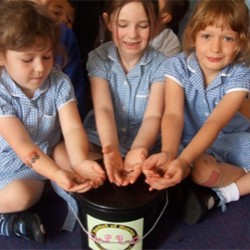 Creative science for schools
Creative science for schools
What can creative intervention do for science education?
The MRC Clinical Sciences Centre and Creative Partnerships were exploring new approaches to science education. Together they funded CSC-based science communicator, Brona McVittie, to produce the second in a series of creative animations to inspire young minds with science. Unlike her prototype production this animation was created in partnership with a group of 8-11 year olds from Exton Primary School in Rutland.
The project was inspired by Darwin’s worm experiments. His curiosity as to the mental power of earthworms led him to observe them over many months in large pots of earth housed in his study. He not only yelled at them, to see if they could hear, but serenaded them with a bassoon. The results of his investigations, and many more, are succinctly compiled into a volume he dedicated to the humble annelid entitled: The formation of vegetable mould through the action of worms with observations on their habits.
Children from Exton Primary were involved in all stages from the science behind the story to the creation of the animation.
The first stage in the project engaged children in the principles of scientific investigation. The team began by setting up an experiment to explore the role that worms play in generating healthy soil. Three large pots were filled with earth and no worms, 50 worms or 100 worms respectively. Every week the children fed the worms vegetable matter that they collected at home. After several weeks it became clear that vegetable matter in the pot with most worms turned over more quickly.
A second series of experiments were devised to test whether worms could hear. Worms were placed in lanes in a tray and subjected to either silence or a noise stimulus. One experiment compared the average speed that worms travelled away from a screaming child with the speed they travelled away from the same child when she wasn’t screaming. A second experiment investigated the difference in speed between worms travelling away from a woodblock, both while it was being beaten and when silent. Each experiment tested a total of 12 worms and each control measurement was compared to the test measurement for that individual.
Worms travelled away from the beating woodblock two to three times faster than when the woodblock remained silent, but no significant difference was evident in the screaming experiment. The children reasoned that the earthworms probably couldn’t hear, but that they may have responded to the vibrations generated by the beating of the woodblock.
The creative side to the project involved a celebration of their scientific research in narrative form. Brona and the children wrote a story about worms, built a film set, wrote a script and shot an animated film: Professor Corkbot and the Lambton Worm.
A series of interviews with the youngsters revealed that the creative intervention had changed their attitude towards science.
